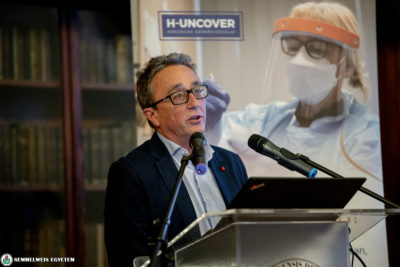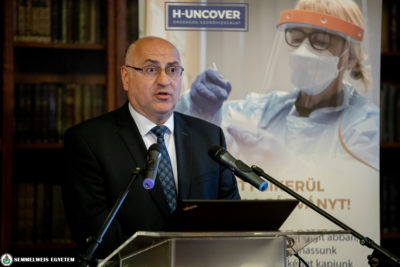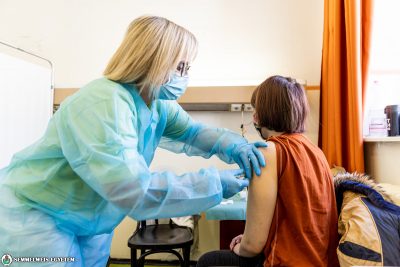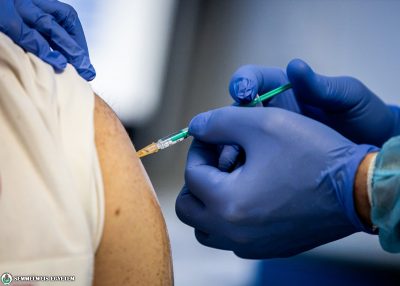The study, which is also significant on an international level, fundamentally sought to examine how many people were infected by the novel coronavirus during the downward trend of the pandemic in Hungary, prior to the easing of restrictions, as well as how many had gone through the infection previously and thus may have acquired immunity against the virus.
Out of the 17,787 people selected by the Hungarian Statistical Office (KSH), a total of 10,575 participated in the study between May 1-16, and provided test samples for at least one type of test. Of these, 10,474 also filled out the accompanying questionnaire, thus this is the number representing the total study population. Taking into account the 13% sample frame error, the rate of participation was thus 67.7%. The study is representative of the Hungarian population over 14 years of age and living in private households. Naso- and oropharyngeal smears and blood samples were collected for polymerase-chain reaction (PCR) and antibody testing to determine whether they had been previously infected, and the testing was also accompanied by a questionnaire.
 Three of the tested individuals had positive PCR tests showing an active infection, and 70 had positive serological (seropositive) tests – analyzed with commercially available Food and Drug Administration (FDA) approved immunological test –, indicating a previous SARS-CoV-2 infection. This means that the estimated number of active infection cases at the time of the study, within the Hungarian population over 14 and not living in an institution, was 2,421, while 56,439 had been previously exposed to the virus. Thus both the active infection rate (2.9 out of 10,000 people) and the prevalence of prior SARS-CoV-2 exposure (68/10,000) can be considered low, announced Dr. Béla Merkely, rector of Semmelweis University, which led the study, at the press conference.
Three of the tested individuals had positive PCR tests showing an active infection, and 70 had positive serological (seropositive) tests – analyzed with commercially available Food and Drug Administration (FDA) approved immunological test –, indicating a previous SARS-CoV-2 infection. This means that the estimated number of active infection cases at the time of the study, within the Hungarian population over 14 and not living in an institution, was 2,421, while 56,439 had been previously exposed to the virus. Thus both the active infection rate (2.9 out of 10,000 people) and the prevalence of prior SARS-CoV-2 exposure (68/10,000) can be considered low, announced Dr. Béla Merkely, rector of Semmelweis University, which led the study, at the press conference.
The results of the questionnaire – based on the symptoms mentioned – indicate that loss of smell or taste and body aches were significantly more frequent among those infected. Shortness of breath and diarrhea was also a common symptom in the seropositive group, and the proportion of people who had chronic diseases was also higher among persons with a positive test, at 54.4% vs. 41.5% for the general population, the rector noted. Infection is also more frequent among those with comorbidities, such as hypertension, cardiac disease, chronic lung, liver, or kidney disease.
The estimates suggest that seropositivity tends to increase by age and is higher among those who commuted regularly to their workplace, were in contact with confirmed infected individual or someone in quarantine and traveled abroad after March 1. However, none of these differences were statistically significant.
The mean age of survey participants was 48.7 years, with 53.6% female and 46.4% male; no significant differences were seen by gender among those with positive tests. By region, the highest prevalence of seropositivity was found in Budapest (90/10,000) and the lowest in Northern Hungary (45/10,000).
The study was led by Semmelweis University with the participation of the Universities of Debrecen, Szeged and Pécs, in collaboration with the Hungarian Central Statistical Office and with the support of the Ministry for Innovation and Technology. Most of the samples were taken by employees of the four medical universities, but officials of the National Ambulance and Water Rescue Services, local GPs, the police, mayors, notaries and other local officials helped out as well. Thanks also go out to all those citizens who took part in the study, each of them representing several hundred other Hungarians. The selected individuals were contacted by mail, phone, or the electronic government portal, and if these proved unsuccessful, home visits were made. The samples were collected by 187 screening teams in 348 fixed screening posts, in five screening buses, and by mobile testing units.
Dr. Béla Merkely emphasized that the study results show that the early introduction of strict containment efforts may have helped restrict the spread of the infection in Hungary. There were also specific safety measures solely applied to elderly people, and the adherence of the Hungarian population to these regulations also likely played a role. The results of the H-UNCOVER study were the basis of the successful exit strategy in Hungary. In the future, it is important to regularly repeat this representative study, especially until a vaccine is developed, the rector stressed, adding that the medical universities will continue screening tests even after the slowing down of the pandemic, in order to fulfill their role as sentinels.
 Kornélia Mag, the deputy president of the KSH, said the role of the statistical office is providing reliable and precise data for users in order to provide a basis for decisionmaking. “As a result of the study, we now have data on how affected Hungary has been by the coronavirus, which is rare even in an international comparison,” she pointed out. It was important to have not only national data, but more detailed data by region and age groups as well, she added. The KSH used a two-stage layered sampling method to select 489 municipalities, after which the individuals invited to take part in the survey were selected by a random systematic method. She also noted that 1245 workers of the four universities and close to 400 volunteers took part in conducting the screening.
Kornélia Mag, the deputy president of the KSH, said the role of the statistical office is providing reliable and precise data for users in order to provide a basis for decisionmaking. “As a result of the study, we now have data on how affected Hungary has been by the coronavirus, which is rare even in an international comparison,” she pointed out. It was important to have not only national data, but more detailed data by region and age groups as well, she added. The KSH used a two-stage layered sampling method to select 489 municipalities, after which the individuals invited to take part in the survey were selected by a random systematic method. She also noted that 1245 workers of the four universities and close to 400 volunteers took part in conducting the screening.
 Dr. Ervin Berényi, president of the Clinical Center of the University of Debrecen, highlighted that that national screening survey created a never-before seen cooperation between the medical universities, local GPs, notaries, mayors and government offices, and it required especially difficult logistics to reach even the most remote villages. “Since the study showed that there is a bigger risk of infection when we go into a community, it is important to carefully consider where we go during the summer vacation,” he said.
Dr. Ervin Berényi, president of the Clinical Center of the University of Debrecen, highlighted that that national screening survey created a never-before seen cooperation between the medical universities, local GPs, notaries, mayors and government offices, and it required especially difficult logistics to reach even the most remote villages. “Since the study showed that there is a bigger risk of infection when we go into a community, it is important to carefully consider where we go during the summer vacation,” he said.
 Dr. Andor Sebestyén, president of the Clinical Center of the University of Pécs, noted the counties where the participation rate was over 75%, which were Veszprém, Nógrád, Szabolcs-Szatmár-Bereg and Békés, as well as Pest County, which was close to this level. “This reflects the hard work of many people, as well as the media, and also indicates that people were curious to know whether they had previously gone through the infection, or were actively infected,” he said. He also spoke about regional differences, noting that in addition to Budapest, Western Transdanubia and the Northern Plains saw the highest rate of previous exposure to the virus, while the infection rate was highest in the capital, Northern Hungary and Central Transdanubia.
Dr. Andor Sebestyén, president of the Clinical Center of the University of Pécs, noted the counties where the participation rate was over 75%, which were Veszprém, Nógrád, Szabolcs-Szatmár-Bereg and Békés, as well as Pest County, which was close to this level. “This reflects the hard work of many people, as well as the media, and also indicates that people were curious to know whether they had previously gone through the infection, or were actively infected,” he said. He also spoke about regional differences, noting that in addition to Budapest, Western Transdanubia and the Northern Plains saw the highest rate of previous exposure to the virus, while the infection rate was highest in the capital, Northern Hungary and Central Transdanubia.
 Dr. Csaba Lengyel, president of the Clinical Center of the University of Szeged, discussed what other factors affected the rate of infection in various regions. One was age, which clearly shows on a global level the high infection rate among elderly people. However, the data show regional variation: while in Eastern Hungary the dominance of older people was clear, in the Central and Transdanubia regions it was younger people that comprised the majority of those who had previous exposure to the virus, resulting from cross-border mobility. This indicates that the virus was most likely introduced to Eastern Hungary from other areas. He also noted that there was no significant statistical difference by age in those with previous exposure, although in Western Hungary and the Central region male patients slightly outnumbered females, while it was the other way around in Northern Hungary.
Dr. Csaba Lengyel, president of the Clinical Center of the University of Szeged, discussed what other factors affected the rate of infection in various regions. One was age, which clearly shows on a global level the high infection rate among elderly people. However, the data show regional variation: while in Eastern Hungary the dominance of older people was clear, in the Central and Transdanubia regions it was younger people that comprised the majority of those who had previous exposure to the virus, resulting from cross-border mobility. This indicates that the virus was most likely introduced to Eastern Hungary from other areas. He also noted that there was no significant statistical difference by age in those with previous exposure, although in Western Hungary and the Central region male patients slightly outnumbered females, while it was the other way around in Northern Hungary.
In response to a journalist query, Dr. Zoltán Vokó, director of Semmelweis University’s Center of Health Technology Assessment and Analysis, said that the testing of sewage water can be used as a complementary testing method in monitoring a new wave of infection, as part of the tracking of how the serology situation develops.
Dr. Attila Szabó, president of the university’s Clinical Center and vice-rector for clinical affairs, also responded to a question from a reporter, noting the importance of not cooling spaces to too low temperatures in the summer period: if it is very hot outside, the optimal indoor temperature is around 25-26 degrees Centigrade.
It was also revealed at the press conference that within the framework of H-UNCOVER, two additional cross-sectional screenings are planned to be carried out by May 1, 2021.
Pálma Dobozi, Orsolya Dávid
Translation: Tamás Deme
Photo: Attila Kovács – Semmelweis University



